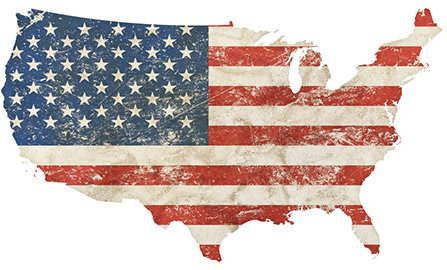The U.S. Has the Highest Rate of Overdose Deaths among Developed Nations

By now it is no new story that the United States is struggling with a pretty severe drug overdose problem. At this time, tens of thousands of people are dying from drug overdoses every year. Though statistics have not yet been tabulated for 2018, more than 70,200 people died from overdoses in 2017. Compare that to 36,000 people dead from drug overdoses in 2007. And compare 2007’s death rate to 16,800 people dead in 1999. In the last 18 years, the drug problem has almost quadrupled from a mortality standpoint.
The 1999 to 2017 graph is not a pretty one. Check out the National Institute on Drug Abuse’s website for more data. They have several charts, and with the help of CDC data they can dissect the intricacies of the death toll, the different drugs involved, the age ranges affected, and so on.
For this discussion, let’s take a look at not only the United States and our country’s overdose data, but let’s also explore some other first-world countries which are more or less comparable to the United States. I want to look at other nations and see if we can learn something from how they address their own drug problems. How do other developed countries keep their overdose rates so low? What are they doing that we aren’t and should be, or what are they not doing that we are doing, that we shouldn’t be?
Data from the World Health Organization
The World Health Organization has a department called the “World Health Rankings.” This department seeks to compile statistics and factual data on causes of death per capita for each nation. Some detailed investigation into their data on drug use deaths per capita of various countries tells us a lot about the severity and the lethality of drug use in multiple countries. For example, The United States ranks as having the fifth highest drug overdose death rate per capita out of 183 countries examined. That’s an eyeopener.
Just as a side note, countries ranked from fourth place to first place are as follows:
- Estonia (4th)
- Russia (3rd)
- Belarus (2nd)
- Ukraine (1st)
Ukraine has the highest rate of drug overdose deaths per capita, with 15.93 people for every 100,000 residents in Ukraine dying from drug use every year. The United States has a rate of 10.21 deaths per every 100,000 residents every year.
Now let’s look at some of the countries which, though they are quite similar to the U.S. in some ways, seem quite capable of avoiding drug overdose deaths. These are:
- South Korea—0.21 drug overdose deaths per every 100,000 residents.
- Portugal—0.76 drug overdose deaths per every 100,000 residents.
- Italy—1.14 drug overdose deaths per every 100,000 residents.
We can draw plenty of similarities between each of these three nations and the United States. So why is it that their drug problems are practically nonexistent and the U.S. drug problem is quite significant? Let’s take a look at each country and see what makes them unique in this area.

South Korea
An excellent article at the Business and Public Administration Studies website draws tight comparisons and contrasts between South Korea and the United States. Their research focused on drug use among U.S. and South Korean college students, but the gist of the data applies to all demographics.
According to their research, “One may attempt to explain the disparity by considering the obvious differences in cultures. Although South Korea is technologically advanced and globalization has affected the nation, the culture remains intact. Of particular interest to this study is the culture’s strong informal social control. South Koreans have a deep respect for past generations.”
The paper goes on to discuss how, though South Korea has advanced technologically, the country has miraculously maintained a large degree of the country’s core principles—family values, respect for elders, respect for the law, an ingrained following of moral codes and ethics, and so on.
As a side note, South Korea has a population density of 498 people per square kilometer, compared to the U.S.’s population density of 32 people per square kilometer. Even though the density of people in South Korea is 15 times greater than it is in the U.S., their homicide rate is almost a third of that of the U.S. And their drug overdose rate is a fraction of what it is in the U.S.
The research indicates that the strength of culture, core values, respect for morals, and traditional ethics are what have contributed to low drug use rates in South Korea. That’s very plausible. How could we in the U.S. work to reinforce traditions, family values, and an overall appreciation for morals and ethical integrity, law abidance, and so on? It’s something to think about.
Portugal

Portugal was a country where one in ten residents were using heroin in the 1980s (one of the most densely concentrated drug problems in Europe at the time). But Portugal made a complete 180 degree turn around at the end of the 20th-century. While Portugal did not legalize all drugs as is sometimes misreported in the media, Portugal did shift its approach to drug use. They started treating drug use as a medical, behavioral issue, not as a criminal issue. They started making drug users go to rehab instead of jail. They decriminalized drug possession of small amounts of drugs when the individual had no intention to distribute.
Please keep in mind that decriminalization is not the same thing as legalization. Drug use is still illegal in Portugal, but the Portuguese no longer treat addicts as criminals. They treat them as addicts, and they help them with addiction treatment. What could we learn from Portugal’s model?
For more information about how Portugal made this incredible transition, Check out NPR’s article.
Italy

When we think of Italy, we probably think of wine and pasta. And maybe the Italians do drink their fair share of wine, but they don’t do much else other than that. Italy has about 60 million people in their country, yet only 266 Italians died from drug overdoses in 2016.
According to the European Monitoring Centre for Drugs and Drug Addiction, there are some concerns about marijuana in Italy, and herbal cannabis and cannabis resin are the two most commonly seized drugs in the nation. But, as a general rule, Italians almost always stay away from hard drugs. We can learn something from that. Marijuana has its dangers, and we know that, but it does not hold a candle to heroin, some pharmaceutical drugs, prescription painkillers, cocaine, methamphetamine, and so on.
Let’s Make It a Learning Experience
We do a lot of things right in the U.S., but our drug problem has placed us in the top five for drug fatalities in the world. And some areas of the U.S. are far worse than others. We need to fix this. We need to change something. South Korea, Portugal, and Italy are making progress in reducing their drug problems and keeping them low. What else can we learn from them and other nations that are doing the same? It’s worth looking into.
Sources:
- https://www.drugabuse.gov/related-topics/trends-statistics/overdose-death-rates
- https://www.worldlifeexpectancy.com/cause-of-death/drug-use/by-country/
- https://www.bpastudies.org/bpastudies/article/view/
- https://www.npr.org/sections/parallels/in-portugal-drug-use-is-treated-as-a-medical-issue-not-a-crime
- http://www.emcdda.europa.eu/countries/drug-reports/2018/italy_en
Reviewed and Edited by Claire Pinelli LADC, CCS, ICCADC, RAS, MCAP


